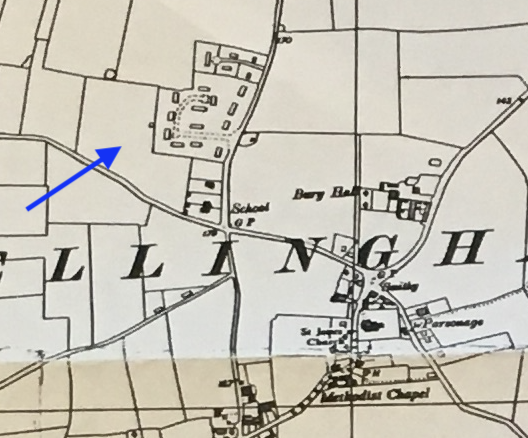On the 28th February, 1931, the Parish Council purchased a piece of land known as ‘Town Piece’ for the purposes of a recreation ground. The blue arrow on the below map shows the location of this ‘L-shaped’ piece of land.

Extract from O.S. Map c.1945. Courtesy Ray & Maureen Beales
Although the Parish Council purchased the land as trustees, the day to day management of the ground was carried out by the newly formed Recreation Ground Committee.
Byelaws
At a meeting held on the 22nd January, 1932, the Recreation Ground Committee provided the Parish Council with a list of proposed byelaws. These were accepted by the Parish Council and sent to the Ministry of Health ‘for examination’ and approval.
In their response dated 8th March, 1932, the Ministry of Health directed the Parish Council to use particular ‘model forms’ in their application.
Further, the Ministry suggested that the Parish Council may like to consider whether the byelaws were necessary as (in their view) ..
“… not only from the standpoint that pleasure grounds can usually, in practice, be controlled otherwise than by a penal code - as to this see the prefatory memorandum to the octavo edition of the model byelaws - but also in the light of the steps now being taken throughout the country to promote national economy.”
They went on to say..
“The byelaws would necessarily involve expense, e.g. printing and advertisement when the byelaws are made and, for enforcing them, the engagement of additional staff or the employment of staff which would be more usefully employed in other work. This expense has to be borne by the public (that is, means a fresh burden on the ratepayers) and in the present circumstances it should, especially where byelaws have not hitherto existed, if possible, be saved.”
Nevertheless, the Parish Council with, presumably, the Recreation Committee, went ahead with the byelaws.
At a meeting of the Parish Council held on the 24th June, 1932, the Chairman, Mr A Spurgeon together with two members Mr G Saunders and Mr A J Pollard, signed two printed copies of the Recreation Ground Byelaws. In accordance with the Ministry of Health’s order, the clerk, Mr W R Lebbell, also signed.
The Ministry of Health added their seal in August 1932.
Byelaws Poster
Posters containing the byelaws were also printed and, in all probability, displayed around the recreation ground.
The byelaws included:
4. A person shall not except in pursuance of a lawful agreement with the Council, or otherwise in the exercise of any lawful right or privilege, bring or cause to be brought on to the ground
(a) any beast of draught or burden or any cattle sheep, goats or pigs; …….Extracted wording taken from a poster of BYELAWS printed by Stone Printer, Attleborough & Wymondham.
Original held at Norfolk Record Office
A quick search on the internet reveals that a ‘beast of burden’ is an animal that carries or pulls heavy loads, such as a donkey, mule or ox.
The byelaws also stated that a breach of any of the eight byelaws could result in a fine of two pounds.
Community Use
The recreation ground has been in continuous use by the inhabitants of Great Ellingham since its acquisition in 1931.
For over 90 years, generations have used the ‘rec’ for the playing of sports, holding events and general social occasions.
We are lucky to have such a large recreational ground in our village.
Sources:
Great Ellingham Parish Council Records. Norfolk Record Office. Cat. Ref. PC116/46
Great Ellingham Parish Council Minutes 1894-1941. Norfolk Record Office Cat. Ref. PC116/10
Great Ellingham Parish Council Plan of Proposed Village Hall [undated]. Norfolk Record Office. Cat. Ref. PC116/56
Great Ellingham Parish Council Byelaws Great Ellingham Recreation Ground. Norfolk Record Office. Cat. Ref. PC116/24
Great Ellingham Parish Council Recreation Ground Byelaws 1932. Norfolk Record Office. Cat. Ref. PC116/25
Great Ellingham Parish Council Norfolk County Council Playing Fields Association Leaflet [undated] Norfolk Record Office. Cat. Ref. PC116/62